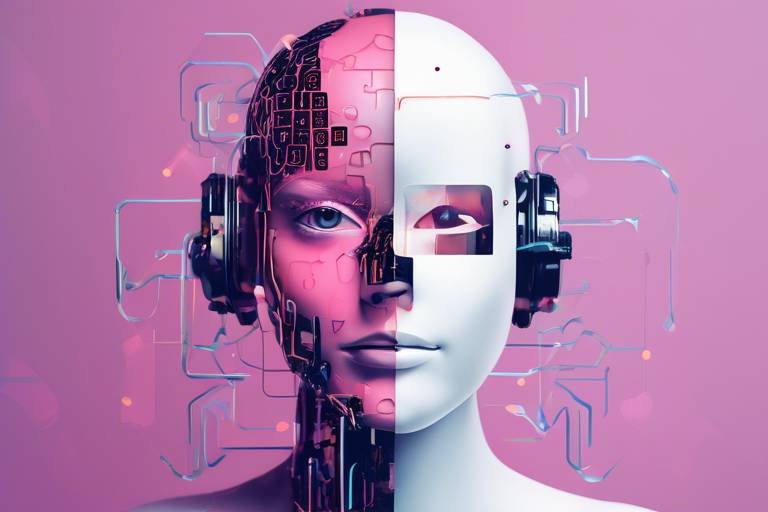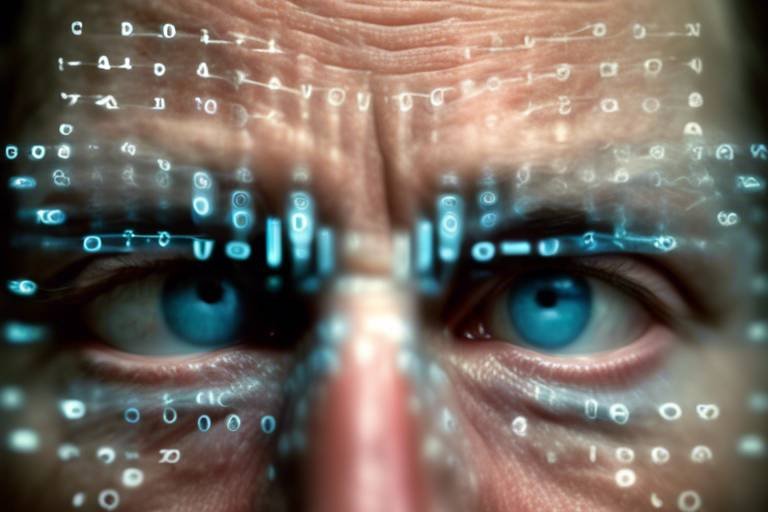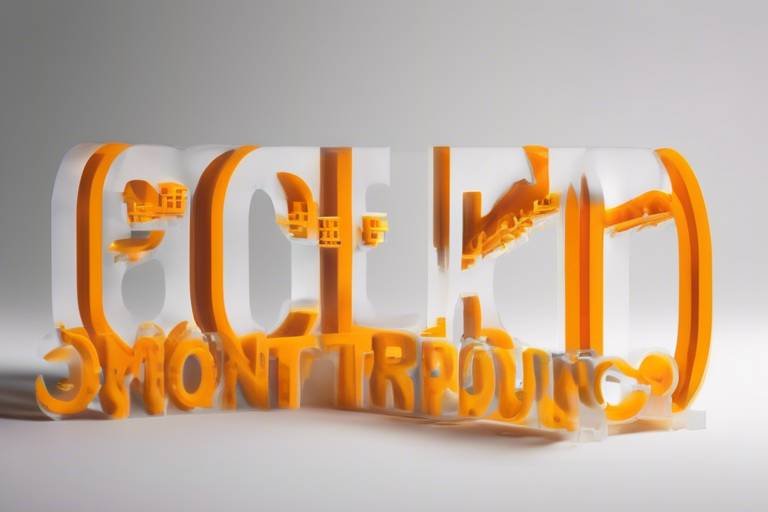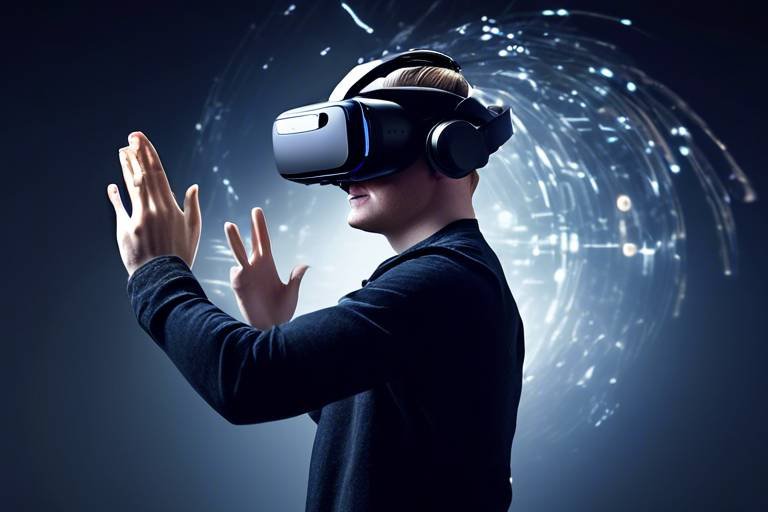Blockchain: A Transformative Technology for Healthcare
In recent years, blockchain technology has emerged as a game-changer in various industries, and healthcare is no exception. Imagine a world where patient data is not only secure but also easily accessible to authorized personnel, ensuring that healthcare providers have the most accurate and up-to-date information at their fingertips. This vision is becoming a reality as blockchain technology revolutionizes the way we manage health data. By leveraging decentralized systems, healthcare organizations can enhance data security, improve patient outcomes, and streamline operations in ways that were previously unimaginable.
At its core, blockchain is a decentralized ledger that records transactions across multiple computers in such a way that the registered transactions cannot be altered retroactively. This characteristic makes it incredibly appealing for healthcare, where data integrity and security are paramount. With the rise of cyber threats and data breaches, the healthcare sector is under increasing pressure to protect sensitive patient information. Blockchain's cryptographic features provide a robust solution to these challenges, ensuring that data remains confidential and tamper-proof.
Moreover, the potential applications of blockchain in healthcare extend far beyond mere data security. From managing patient consent to preventing fraud, the technology offers a plethora of benefits that can enhance the overall efficiency of healthcare systems. For instance, consider the way we currently manage patient records. Traditional systems often suffer from interoperability issues, leading to fragmented care and poor patient outcomes. Blockchain can facilitate seamless data exchange between different healthcare providers, creating a more cohesive and integrated healthcare experience for patients.
As we delve deeper into the applications of blockchain in healthcare, we will explore how it is transforming clinical trials, improving data integrity, and enhancing participant engagement. The future looks bright, but it's essential to address the challenges and limitations that come with implementing such a revolutionary technology. From scalability concerns to regulatory hurdles, understanding these issues is crucial for the successful adoption of blockchain in healthcare.
In summary, blockchain technology holds the promise of a more secure, efficient, and patient-centered healthcare system. As we continue to explore its various applications and benefits, it's clear that this transformative technology is set to change the landscape of healthcare for the better.
- What is blockchain technology?
Blockchain is a decentralized digital ledger that records transactions across multiple computers, ensuring that the information is secure and cannot be altered retroactively.
- How does blockchain enhance data security in healthcare?
Blockchain uses cryptographic features to protect sensitive health information from unauthorized access, ensuring compliance with regulations such as HIPAA.
- Can blockchain improve patient outcomes?
Yes, by allowing seamless data exchange between healthcare providers, blockchain can lead to better-coordinated care and improved patient outcomes.
- What are the challenges of implementing blockchain in healthcare?
Challenges include scalability issues, regulatory compliance, and the need for collaboration among various stakeholders in the healthcare ecosystem.

Understanding Blockchain Technology
Blockchain technology is often described as a decentralized ledger that records transactions across multiple computers in such a way that the registered transactions cannot be altered retroactively. Imagine a digital notebook that everyone can see and write in, but once something is written down, it cannot be erased or changed. This is the essence of blockchain: it ensures transparency and security in data management. Instead of relying on a central authority, blockchain operates on a network of computers, known as nodes, which collectively validate and store data. This structure not only enhances security but also promotes trust among users, as everyone has access to the same information.
At its core, a blockchain consists of a series of blocks, each containing a list of transactions. Each block is linked to the previous one through a cryptographic hash, creating a chain of blocks—hence the name "blockchain." This connection ensures that if someone attempts to alter a block, it would change the hash and break the chain, making the tampering evident. Furthermore, the use of cryptography in securing these transactions means that unauthorized access is significantly minimized, making sensitive information much harder to breach.
One of the most fascinating aspects of blockchain is its decentralized nature. Unlike traditional databases, which are controlled by a single entity, blockchain distributes control across all participants in the network. This means that no single point of failure exists, making the system more resilient against attacks. Additionally, the consensus mechanism employed by blockchain networks, such as Proof of Work or Proof of Stake, ensures that all transactions are verified and agreed upon by the majority of the network before they are added to the chain.
To further illustrate the functionality of blockchain, consider the following table that outlines the key components of blockchain technology:
| Component | Description |
|---|---|
| Block | A unit of data containing transactions. |
| Chain | The sequence of blocks linked together. |
| Node | Each computer participating in the blockchain network. |
| Consensus Mechanism | The method used to validate transactions (e.g., Proof of Work). |
| Cryptographic Hash | A secure function that converts data into a fixed-length string. |
In summary, understanding blockchain technology is crucial for grasping its potential impact on various industries, especially healthcare. Its ability to provide a secure, transparent, and decentralized way of managing data is what makes it a revolutionary tool. As we delve deeper into the benefits and applications of blockchain in healthcare, keep in mind that this technology is not just a passing trend; it is poised to fundamentally change how we think about data security and patient care.

Benefits of Blockchain in Healthcare
Blockchain technology is not just a buzzword; it’s a game-changer for the healthcare industry. Imagine a world where your medical records are not only secure but also easily accessible by authorized personnel anytime and anywhere. This is the promise of blockchain. By leveraging its core principles, healthcare providers can enhance data security, improve interoperability, and streamline operations. Let’s dive deeper into these benefits and see how blockchain is reshaping the healthcare landscape.
One of the standout features of blockchain is its cryptographic security. Each transaction is encrypted and linked to the previous one, forming a chain that is incredibly difficult to tamper with. This means sensitive health information is protected from unauthorized access. For instance, if a hacker tries to alter a patient’s medical record, they would need to change every block in the chain, which is virtually impossible. This level of security not only ensures patient privacy but also helps healthcare organizations comply with regulations like HIPAA, which mandate strict data protection measures.
With blockchain, managing patient consent becomes a breeze. Traditionally, obtaining consent for data sharing can be a cumbersome process, often requiring multiple signatures and lengthy paperwork. However, blockchain allows for a streamlined process where patients can easily grant or revoke access to their data in real-time. This not only empowers patients but also builds trust in healthcare systems, as they have full control over who accesses their information.
Healthcare fraud is a significant issue, costing billions each year. Blockchain’s inherent transparency and immutability can play a crucial role in combating this problem. By creating a permanent record of all transactions, blockchain ensures that claims and billing processes are accurate and trustworthy. For example, every prescription filled can be logged on the blockchain, making it easier to identify and prevent fraudulent activities. This not only protects healthcare providers but also ensures that patients receive the care they need without unnecessary costs.
Another significant advantage of blockchain in healthcare is its ability to facilitate seamless data exchange between different systems. In today’s fragmented healthcare landscape, providers often struggle to access comprehensive patient data due to siloed systems. Blockchain can bridge this gap by providing a decentralized platform where all authorized parties can access the same up-to-date information. This improved interoperability enhances collaboration among healthcare providers, leading to better patient care and outcomes.
Q: How does blockchain enhance data security in healthcare?
A: Blockchain enhances data security through its cryptographic features, making it extremely difficult for unauthorized users to access or alter sensitive health information.
Q: Can patients control who accesses their medical records using blockchain?
A: Yes, blockchain allows patients to grant or revoke access to their medical records in real-time, giving them greater control over their personal data.
Q: How does blockchain help prevent healthcare fraud?
A: Blockchain's transparency ensures that all transactions are recorded and immutable, making it easier to identify fraudulent activities in billing and claims processes.
Q: What role does blockchain play in improving interoperability?
A: Blockchain provides a decentralized platform for data exchange, allowing different healthcare systems to access and share patient information seamlessly, thus improving collaboration and patient care.

Enhanced Data Security
In today's digital age, where data breaches and cyber threats loom large, the healthcare sector must prioritize data security more than ever. Blockchain technology emerges as a beacon of hope, offering robust solutions to safeguard sensitive health information. At its core, blockchain is a decentralized ledger that employs cryptographic techniques to secure data, ensuring that only authorized individuals can access patient records. This layer of security is critical, especially in an industry that handles highly confidential information, such as medical histories, treatment plans, and personal identification details.
One of the most significant advantages of blockchain is its ability to provide an immutable record of transactions. Once data is entered into the blockchain, it cannot be altered or deleted without consensus from the network participants. This characteristic not only prevents unauthorized alterations but also enhances accountability. Imagine a scenario where a patient's medical record is tampered with; the blockchain would flag such discrepancies, thus maintaining the integrity of the information. This level of transparency is essential for building trust among patients and healthcare providers alike.
Moreover, compliance with regulations like HIPAA (Health Insurance Portability and Accountability Act) is paramount in healthcare. Blockchain's inherent design can facilitate compliance by providing a secure framework for data sharing while ensuring that patient consent is obtained and documented appropriately. For instance, when a patient decides to share their medical records with a specialist, blockchain can track this consent, ensuring that only the intended recipient has access to the information. This not only empowers patients but also strengthens their trust in the healthcare system.
Another critical aspect of enhanced data security through blockchain is its role in fraud prevention. Healthcare fraud is a pervasive issue, costing the industry billions annually. By utilizing blockchain, healthcare organizations can create transparent billing processes where all transactions are recorded and verified on the blockchain. This means that any fraudulent activities, such as billing for services not rendered, can be easily identified and addressed. The decentralized nature of blockchain further reduces the risk of single points of failure, making it much harder for malicious actors to compromise the system.
In summary, the integration of blockchain technology in healthcare offers a multi-faceted approach to enhancing data security. From protecting sensitive information with cryptographic features to ensuring compliance with regulations and preventing fraud, blockchain stands out as a transformative force. As the healthcare industry continues to evolve, embracing such innovative technologies is not just an option; it is a necessity to protect patient privacy and ensure the integrity of health data.
- What is blockchain technology?
Blockchain is a decentralized digital ledger that records transactions across multiple computers securely and transparently.
- How does blockchain enhance data security in healthcare?
By using cryptographic techniques, blockchain ensures that sensitive health information is protected from unauthorized access and alterations.
- Can blockchain help in preventing healthcare fraud?
Yes, the transparency and immutability of blockchain make it difficult for fraudulent activities to go undetected, ensuring accurate billing and claims processes.
- Is patient consent management improved with blockchain?
Absolutely! Blockchain can streamline the process of obtaining and managing patient consent, enhancing trust and empowering patients.

Patient Consent Management
In the rapidly evolving landscape of healthcare, is becoming increasingly vital. With the advent of blockchain technology, the way we handle patient consent is undergoing a significant transformation. Traditionally, obtaining and managing consent has been a cumbersome process, often involving mountains of paperwork and a lack of transparency. This not only frustrates patients but also poses risks related to privacy and compliance. However, blockchain offers a solution that can streamline this process, making it more efficient and secure.
Imagine a world where patients have complete control over their health data, where they can easily grant or revoke access to their information with a simple click. This is the promise of blockchain in patient consent management. By utilizing a decentralized ledger, healthcare providers can ensure that consent is recorded in an immutable way, meaning that once a patient gives consent, it cannot be altered or deleted without their knowledge. This level of security fosters trust between patients and healthcare systems, as individuals can be confident that their data is being handled appropriately.
Furthermore, blockchain enables real-time tracking of consent. This means that healthcare providers can instantly verify whether they have the necessary permissions to access a patient's data, reducing the risk of unauthorized access. For instance, if a patient decides to participate in a clinical trial, they can easily grant consent through a secure blockchain application. The trial organizers can then access the relevant data without having to navigate through layers of bureaucracy, leading to faster and more efficient research processes.
Moreover, the use of smart contracts—self-executing contracts with the terms of the agreement directly written into code—can automate the consent process. For example, a smart contract can automatically update a patient's consent status whenever they make a change, ensuring that all parties are informed in real-time. This not only enhances operational efficiency but also empowers patients, giving them a sense of agency over their health information.
In summary, blockchain technology is revolutionizing patient consent management by making it more secure, transparent, and efficient. The benefits are clear: improved trust, streamlined processes, and enhanced patient empowerment. As we continue to explore the potential of blockchain in healthcare, it's essential to address the challenges that come with it, ensuring that the implementation is both effective and compliant with existing regulations.
- What is blockchain technology? Blockchain is a decentralized digital ledger that securely records transactions across multiple computers.
- How does blockchain enhance patient consent management? It provides a secure, transparent, and immutable record of consent, allowing patients to easily manage their data sharing preferences.
- What are smart contracts? Smart contracts are self-executing contracts with the terms directly written into code, automating processes and reducing the need for intermediaries.
- Is patient data safe on the blockchain? Yes, blockchain's cryptographic features help protect sensitive data from unauthorized access, ensuring patient privacy.
- What challenges does blockchain face in healthcare? Some challenges include scalability, regulatory compliance, and the need for industry-wide collaboration.

Fraud Prevention
Fraud in healthcare is a pervasive issue that not only drains financial resources but also undermines trust in the entire system. Imagine a world where every claim submitted is scrutinized with the utmost transparency, where every transaction is recorded immutably, and where patients can trust that their health data is secure. Blockchain technology offers a revolutionary solution to combat healthcare fraud through its unique features of transparency and immutability.
At its core, blockchain functions as a decentralized ledger that records transactions across multiple computers. This means that once data is entered into the blockchain, it cannot be altered without consensus from all parties involved. As a result, healthcare providers and insurers can rely on a single source of truth. This drastically reduces the chances of fraudulent activities such as billing for services not rendered, duplicate claims, or altering patient records for financial gain.
Moreover, the transparency that blockchain provides allows for real-time monitoring of transactions. Stakeholders can trace the entire lifecycle of a claim—from submission to payment—ensuring that every step is legitimate. For instance, if a healthcare provider submits a claim, it can be verified against the patient's treatment history stored on the blockchain. This verification process not only expedites claims processing but also enhances accountability among providers and payers.
To illustrate the impact of blockchain on fraud prevention, consider the following table:
| Fraud Type | Traditional Method | Blockchain Solution |
|---|---|---|
| Billing for services not rendered | Manual audits | Real-time verification through immutable records |
| Duplicate claims | Claims review processes | Automatic detection through shared ledger |
| Altered patient records | Paper trails and local databases | Secure, tamper-proof storage |
In addition to these mechanisms, blockchain can also enable the use of smart contracts—self-executing contracts with the terms of the agreement directly written into code. These smart contracts can automatically trigger payments once certain conditions are met, further reducing the potential for fraud. For instance, if a patient receives a treatment that is pre-approved and documented on the blockchain, the payment can be processed automatically without the need for manual intervention, minimizing human error and intentional fraud.
Ultimately, the integration of blockchain technology in healthcare not only helps in fraud prevention but also fosters an environment of trust and accountability. Patients can feel confident that their data is protected, and providers can focus on delivering quality care rather than navigating the complexities of fraudulent claims. As the healthcare industry continues to evolve, embracing blockchain could be the key to unlocking a more secure and efficient future.
- What is blockchain technology? Blockchain is a decentralized digital ledger that records transactions across many computers in a way that the registered transactions cannot be altered retroactively.
- How does blockchain prevent fraud in healthcare? By providing a transparent and immutable record of transactions, blockchain reduces the chances of fraudulent activities and enhances accountability among healthcare providers.
- What are smart contracts? Smart contracts are self-executing contracts with the terms directly written into code, allowing for automatic execution of agreements once conditions are met.
- Can blockchain be integrated with existing healthcare systems? Yes, blockchain can be integrated with existing systems to enhance security and efficiency, although it may require collaboration and adjustments to current processes.

Improved Interoperability
Imagine a world where your health data seamlessly flows from one provider to another, as effortlessly as a river winding through a valley. That’s the magic of blockchain technology in healthcare! One of the standout features of blockchain is its ability to enhance interoperability among different healthcare systems. This means that healthcare providers, hospitals, and clinics can share patient information securely and efficiently, breaking down the silos that often hinder patient care. In a traditional system, patient records might be scattered across various platforms, leading to delays and miscommunication. But with blockchain, all authorized parties can access a single, immutable version of a patient's data, ensuring that everyone is on the same page.
The key to this interoperability lies in blockchain's decentralized nature. By utilizing a shared ledger, healthcare entities can interact without needing a central authority to validate transactions. This not only speeds up the process but also reduces the risk of data breaches. When a patient visits a new specialist, for instance, their complete medical history can be accessed instantly, allowing for quicker diagnoses and treatment plans. This level of access can significantly improve patient outcomes, as doctors can make informed decisions based on comprehensive data rather than piecemeal information.
Furthermore, blockchain can facilitate the integration of various health technologies, such as Electronic Health Records (EHRs), telemedicine platforms, and wearable health devices. This integration creates a holistic view of a patient's health, enabling providers to offer more personalized care. For example, if a patient uses a wearable device that monitors their heart rate, that data can be securely transmitted to their healthcare provider via blockchain. This real-time data sharing can alert doctors to potential issues before they become critical, paving the way for proactive healthcare.
However, achieving true interoperability is not without its challenges. Healthcare systems are often built on legacy technologies that may not easily integrate with new blockchain solutions. Additionally, varying standards for data formats can create hurdles. To overcome these challenges, stakeholders must collaborate and agree on common protocols and standards. The potential benefits of improved interoperability are immense, and with continued innovation and cooperation, we can look forward to a future where healthcare is more connected than ever before.
- What is interoperability in healthcare? Interoperability refers to the ability of different healthcare systems and technologies to communicate and exchange data effectively.
- How does blockchain enhance interoperability? Blockchain provides a secure, decentralized platform for sharing patient data, ensuring that all authorized parties can access accurate and up-to-date information.
- What are the challenges to achieving interoperability? Challenges include legacy systems, varying data standards, and the need for collaboration among stakeholders in the healthcare industry.
- Can blockchain improve patient outcomes? Yes, by providing comprehensive and real-time access to patient data, blockchain can help healthcare providers make informed decisions, leading to better patient care.

Blockchain Applications in Clinical Trials
Blockchain technology is making significant waves in the realm of clinical trials, fundamentally transforming how research is conducted and data is managed. One of the most compelling advantages of blockchain is its ability to ensure data integrity and transparency. Imagine a world where every piece of data collected during a trial is securely recorded on a decentralized ledger that is immutable—meaning it cannot be altered or deleted. This level of security fosters trust among stakeholders, including researchers, regulatory bodies, and participants, as they can all access the same verified information. It’s like having a digital vault that not only protects sensitive data but also allows everyone involved to see the same unchangeable record of the trial's progress.
Moreover, participant recruitment and retention are crucial elements that can make or break a clinical trial. Traditional methods often struggle with inefficiencies, leading to delays and increased costs. However, blockchain introduces innovative solutions that enhance participant engagement. For instance, smart contracts—self-executing contracts with the terms of the agreement directly written into code—can automate many processes related to recruitment. This means that once a participant meets specific criteria, they can be automatically enrolled in a trial without the need for cumbersome paperwork. This streamlined approach not only accelerates recruitment but also keeps participants informed and engaged throughout the process.
In addition to these benefits, blockchain can significantly enhance transparency throughout the research process. By allowing all stakeholders to track the progress of a clinical trial in real-time, it mitigates concerns about data manipulation and unethical practices. For example, if a researcher tries to alter results, the blockchain will record the original data, making it impossible to hide discrepancies. This level of oversight is not just beneficial for maintaining the integrity of the trial; it also boosts public confidence in the research outcomes, which is essential for the acceptance of new treatments and therapies.
However, while the potential of blockchain in clinical trials is immense, it is essential to address the challenges of implementation. For instance, the initial setup of a blockchain system can be resource-intensive, requiring significant investment in technology and training. Additionally, there may be resistance from traditional stakeholders who are accustomed to existing systems. Overcoming these barriers will necessitate collaboration across the healthcare ecosystem, ensuring that all parties understand the benefits and functionalities of blockchain.
As we look to the future, the integration of blockchain technology in clinical trials is poised to revolutionize how we conduct medical research. The ability to ensure data integrity, enhance participant engagement, and promote transparency can lead to more successful trials and, ultimately, better patient outcomes. With the right approach, blockchain could be the key to unlocking a new era of innovation in healthcare research.
- What is blockchain technology? Blockchain is a decentralized digital ledger that securely records transactions across multiple computers, ensuring that the data cannot be altered retroactively.
- How does blockchain improve clinical trials? By ensuring data integrity, enhancing transparency, and streamlining participant recruitment and retention processes.
- Are there challenges to implementing blockchain in healthcare? Yes, challenges include scalability, regulatory compliance, and the need for industry-wide collaboration.
- What are smart contracts? Smart contracts are self-executing contracts with the terms directly written into code, allowing for automated processes in various applications, including clinical trials.

Data Integrity and Transparency
In the realm of clinical trials, data integrity and transparency are paramount. Stakeholders, including researchers, regulatory bodies, and participants, demand assurance that the data collected is not only accurate but also remains unchanged throughout the study. This is where blockchain technology shines. By utilizing a decentralized ledger, blockchain ensures that once data is entered, it cannot be altered or deleted without consensus from the network. This immutability fosters a level of trust that traditional data management systems often struggle to provide.
Consider the traditional methods of data collection in clinical trials. Often, data is stored in centralized databases that are vulnerable to breaches and manipulation. A single point of failure can lead to significant issues, such as fraudulent activities or erroneous results. In contrast, blockchain distributes data across a network of computers, making it nearly impossible for any single entity to tamper with the information without detection. This revolutionary approach not only enhances the credibility of research outcomes but also promotes a culture of accountability among researchers and sponsors.
The transparency offered by blockchain is another critical aspect that benefits clinical trials. All transactions and data entries on a blockchain are recorded in a way that is visible to all authorized participants. This means that stakeholders can audit and verify the data in real-time, leading to increased trust in the results. For instance, if a participant wants to verify how their data has been used, they can easily trace it back through the blockchain, ensuring that their information is handled ethically and responsibly.
Moreover, the integration of blockchain can significantly reduce the time and effort spent on data reconciliation. Traditionally, researchers often face the tedious task of cross-verifying data from multiple sources, which can be both time-consuming and prone to errors. With blockchain, all data is stored in a single, unified system that is accessible to all parties involved in the trial. This streamlined approach not only saves time but also enhances the overall efficiency of the research process.
To illustrate the impact of blockchain on data integrity and transparency, consider the following table:
| Traditional System | Blockchain System |
|---|---|
| Centralized data storage | Decentralized ledger |
| Vulnerable to single point failures | Resilient against tampering |
| Time-consuming data verification | Real-time audit capabilities |
| Limited transparency | Full visibility for authorized users |
In conclusion, the adoption of blockchain technology in clinical trials is not just a trend; it represents a fundamental shift towards a more secure, transparent, and trustworthy research environment. By ensuring data integrity and promoting transparency, blockchain has the potential to revolutionize the way clinical trials are conducted, ultimately leading to better patient outcomes and advancements in medical research.
- What is blockchain technology? Blockchain is a decentralized digital ledger that securely records transactions across multiple computers, ensuring that the recorded information cannot be altered retroactively.
- How does blockchain improve data integrity in clinical trials? By providing an immutable record of data entries, blockchain ensures that once data is recorded, it cannot be changed without consensus, thus maintaining its integrity.
- What are the benefits of transparency in clinical trials? Transparency helps build trust among stakeholders by allowing them to verify data and processes easily, reducing the risk of fraud and enhancing the credibility of research outcomes.

Participant Recruitment and Retention
In the realm of clinical trials, are pivotal for the success of research studies. Traditional methods often fall short, leading to delays and increased costs. However, blockchain technology is stepping in as a game changer, offering innovative solutions that enhance participant engagement and streamline the recruitment process. Imagine a world where potential participants can easily access information about trials that are relevant to them, all while ensuring their data remains secure and private. This is the promise that blockchain holds.
One of the standout features of blockchain is its ability to create a decentralized platform where participants can connect directly with researchers. This opens the door for improved communication and transparency. Participants can verify the legitimacy of trials and understand their role in the research process, which significantly boosts their trust and willingness to participate. Furthermore, utilizing smart contracts, researchers can automate the consent process, making it simpler for participants to enroll while ensuring that their rights are protected.
Retention is another critical aspect where blockchain shines. By maintaining a transparent ledger of participant interactions and commitments, researchers can engage participants more effectively throughout the trial. For instance, they can send personalized updates about the study's progress, which fosters a sense of belonging and importance among participants. Additionally, blockchain can facilitate rewards systems for participants, enhancing their motivation to remain engaged. Imagine receiving tokens for completing surveys or attending follow-up appointments; this not only incentivizes participation but also contributes to a positive experience.
Moreover, blockchain's ability to securely store participant data means that researchers can better understand participant demographics and preferences. This data can be analyzed to tailor recruitment strategies, ensuring that the right participants are approached for the right trials. As a result, not only is the recruitment process faster and more efficient, but it also leads to a more diverse participant pool, which is essential for the validity of clinical research.
In summary, the integration of blockchain technology into participant recruitment and retention strategies is revolutionizing the way clinical trials are conducted. By enhancing transparency, improving communication, and creating a more engaging experience for participants, blockchain is paving the way for more successful and efficient clinical research. As we look to the future, it’s clear that this technology will play an essential role in shaping the landscape of clinical trials.
- What is blockchain technology? Blockchain is a decentralized digital ledger that securely records transactions across multiple computers, ensuring that the data is transparent and immutable.
- How does blockchain improve participant recruitment? Blockchain enhances recruitment by providing a secure platform for participants to connect with researchers, ensuring transparency and trust in the trial process.
- Can blockchain help retain participants in clinical trials? Yes, by automating communication and providing incentives, blockchain can significantly improve participant retention rates.
- What are smart contracts? Smart contracts are self-executing contracts with the terms of the agreement directly written into code, allowing for automated processes in recruitment and consent management.
- Is participant data safe on a blockchain? Yes, blockchain utilizes advanced cryptographic techniques to ensure that participant data is secure and only accessible to authorized parties.

Challenges and Limitations of Blockchain in Healthcare
While blockchain technology holds immense potential for revolutionizing healthcare, it's not without its challenges and limitations. One of the primary concerns is scalability. The healthcare sector generates an enormous amount of data daily, and traditional blockchain systems may struggle to handle this volume efficiently. As patient records, clinical trial data, and billing information accumulate, the need for a robust infrastructure that can process and store this data without lag becomes crucial. If blockchain networks cannot scale effectively, they risk becoming bottlenecks rather than solutions.
Moreover, the regulatory landscape surrounding blockchain in healthcare is still evolving. Healthcare is one of the most regulated industries, and integrating blockchain requires alignment with existing laws and standards, such as HIPAA in the United States. This can create a complex web of compliance issues that organizations must navigate carefully. For instance, how can patient data be securely shared on a public blockchain while adhering to privacy regulations? This question remains a significant hurdle.
Another challenge is the necessity for industry-wide collaboration. Implementing blockchain solutions effectively requires buy-in from various stakeholders, including healthcare providers, insurers, and technology vendors. Without a unified approach, efforts to incorporate blockchain may lead to fragmented systems that do not communicate effectively with one another. This lack of interoperability can hinder the very benefits blockchain aims to provide, such as seamless data sharing and enhanced patient care.
Additionally, there is a knowledge gap within the healthcare workforce regarding blockchain technology. Many healthcare professionals may not fully understand how blockchain works or its potential benefits. This lack of understanding can lead to resistance in adopting new technologies. Educational initiatives and training programs are essential to bridge this gap and encourage the adoption of blockchain solutions.
Lastly, the initial investment required to implement blockchain technology can be daunting for many healthcare organizations. Developing and maintaining a blockchain infrastructure demands significant financial resources, which may not be feasible for smaller practices or institutions. Thus, while the long-term benefits of blockchain may be substantial, the upfront costs can deter organizations from pursuing this transformative technology.
In conclusion, while blockchain technology presents exciting opportunities for the healthcare sector, it also faces several challenges that need addressing. Stakeholders must work collaboratively to overcome scalability issues, navigate regulatory landscapes, foster industry-wide cooperation, enhance workforce education, and manage financial investments. By tackling these challenges head-on, the healthcare industry can unlock the full potential of blockchain, leading to improved patient outcomes and operational efficiencies.
- What is the biggest challenge of implementing blockchain in healthcare?
The biggest challenge is scalability, as healthcare generates vast amounts of data that need to be processed efficiently. - How does regulation affect blockchain in healthcare?
Healthcare is heavily regulated, and blockchain implementations must comply with laws like HIPAA, creating complex compliance issues. - Why is industry-wide collaboration important for blockchain?
Collaboration ensures that different stakeholders can effectively communicate and share data, maximizing the benefits of blockchain technology. - What can be done to educate healthcare professionals about blockchain?
Educational initiatives and training programs can help bridge the knowledge gap and promote the adoption of blockchain solutions. - Are there significant costs associated with blockchain implementation?
Yes, the initial investment for developing and maintaining blockchain technology can be substantial, particularly for smaller organizations.

Scalability Concerns
When it comes to implementing blockchain technology in healthcare, one of the most pressing issues is scalability. As the healthcare industry generates an enormous amount of data daily, the ability of blockchain to handle this volume efficiently is crucial. Imagine a bustling highway during rush hour; if too many vehicles attempt to merge onto the same road, traffic slows to a crawl. Similarly, if blockchain networks are not designed to accommodate large volumes of transactions, they can become congested, leading to delays and inefficiencies in data processing.
Currently, many blockchain platforms face challenges in scaling their operations. For instance, traditional blockchain systems like Bitcoin and Ethereum can only process a limited number of transactions per second. This limitation can be particularly problematic in healthcare settings, where timely access to patient data can be a matter of life and death. To illustrate this point, consider the following table that compares the transaction speeds of various blockchain platforms:
| Blockchain Platform | Transactions per Second (TPS) |
|---|---|
| Bitcoin | 7 |
| Ethereum | 30 |
| Ripple | 1,500 |
| Solana | 65,000+ |
This table highlights that while some platforms like Solana can handle a significant number of transactions, others like Bitcoin and Ethereum struggle to keep up with the demands of modern healthcare systems. As a result, the quest for scalable solutions is ongoing, with many developers exploring innovative approaches to enhance performance.
One promising solution to scalability concerns is the implementation of layer-two solutions. These systems operate on top of the existing blockchain and can process transactions off-chain before settling them back on the main chain. This approach can significantly increase transaction speeds and reduce congestion. However, it also introduces complexity and may require additional trust in the secondary layer, which could be a hurdle in the highly regulated healthcare environment.
Moreover, the need for interoperability between different blockchain systems adds another layer of complexity. Just like different car manufacturers need to ensure their vehicles can communicate with one another for safety and efficiency, blockchain systems used by various healthcare providers must be able to share information seamlessly. Without this capability, scalability efforts could be hampered, leading to fragmented systems that fail to deliver the promised benefits of blockchain technology.
In conclusion, while scalability remains a significant concern for blockchain in healthcare, ongoing research and development are paving the way for more robust solutions. As technology continues to evolve, the hope is that these challenges will be addressed, allowing for a future where blockchain can fully realize its potential in transforming healthcare.
- What is blockchain technology? Blockchain is a decentralized digital ledger that records transactions across many computers so that the registered transactions cannot be altered retroactively.
- How does blockchain enhance data security in healthcare? By using cryptographic techniques, blockchain ensures that sensitive health information is protected from unauthorized access and breaches.
- What are layer-two solutions? Layer-two solutions are secondary frameworks built on top of a blockchain that help to improve transaction speeds and scalability without compromising the security of the main blockchain.
- Can blockchain solve interoperability issues in healthcare? Yes, blockchain has the potential to facilitate better data sharing and interoperability between different healthcare systems, enhancing patient care.

Regulatory and Compliance Issues
As blockchain technology continues to carve its niche in the healthcare sector, it brings along a host of regulatory and compliance challenges that stakeholders must navigate. The healthcare industry is already heavily regulated, and the introduction of blockchain adds another layer of complexity. One of the primary concerns is ensuring that blockchain implementations comply with existing laws such as the Health Insurance Portability and Accountability Act (HIPAA) in the United States, which safeguards patient information. Failure to comply with these regulations can result in severe penalties for healthcare providers and organizations.
Moreover, the decentralized nature of blockchain poses questions about accountability. When data is stored across multiple nodes, determining who is responsible for data breaches or inaccuracies can become murky. This is particularly concerning in healthcare, where the integrity of patient data is paramount. Regulatory bodies are still figuring out how to approach these issues, and as a result, there is a lack of clear guidelines for healthcare organizations looking to adopt blockchain technology.
Another significant hurdle is the need for interoperability between blockchain systems and existing healthcare IT infrastructure. For blockchain to be effective, it must seamlessly integrate with Electronic Health Records (EHRs), billing systems, and other platforms. This integration often requires extensive collaboration between different stakeholders, including technology providers, healthcare organizations, and regulatory agencies. Without a unified approach, the risk of fragmentation in healthcare data systems increases, potentially undermining the very benefits that blockchain aims to deliver.
To illustrate the regulatory landscape, consider the following table, which outlines some key regulatory issues associated with blockchain in healthcare:
| Regulatory Issue | Description |
|---|---|
| Data Privacy | Ensuring patient data remains confidential and secure under laws like HIPAA. |
| Accountability | Determining liability in cases of data breaches or inaccuracies in decentralized systems. |
| Interoperability | Facilitating seamless integration with existing healthcare IT systems. |
| Standardization | Establishing uniform protocols for data sharing and management across different platforms. |
In conclusion, while blockchain presents exciting opportunities for improving healthcare, the regulatory and compliance landscape is complex and evolving. Stakeholders must stay informed and collaborate closely to develop solutions that not only comply with regulations but also enhance patient care and data security. As the technology matures, we can expect more clarity from regulatory bodies, paving the way for broader adoption of blockchain in healthcare.
- What are the main regulatory challenges for blockchain in healthcare? The main challenges include data privacy concerns, accountability for data breaches, interoperability with existing systems, and the need for standardization.
- How does blockchain ensure compliance with HIPAA? Blockchain can enhance compliance by providing secure, immutable records of patient data access and consent, but it must be implemented carefully to adhere to HIPAA requirements.
- What role do regulatory bodies play in blockchain adoption? Regulatory bodies provide guidelines and standards that help ensure blockchain implementations are compliant with existing laws, which is critical for healthcare organizations.

The Future of Blockchain in Healthcare
The future of blockchain in healthcare is not just a fleeting trend; it’s a transformative force that promises to redefine how we approach patient care, data management, and operational efficiency. As we look ahead, the integration of blockchain technology with other emerging technologies like Artificial Intelligence (AI) and the Internet of Things (IoT) is poised to create a more interconnected and patient-centric healthcare ecosystem. Imagine a world where your health records are not only secure but also easily accessible to authorized providers, ensuring that you receive the best possible care without unnecessary delays. This level of integration could revolutionize patient outcomes and streamline processes across the board.
One of the most exciting prospects is the potential for blockchain to enhance global health solutions. Picture this: a decentralized network that allows for real-time data sharing across borders, enabling healthcare providers to quickly respond to epidemics or public health crises. With blockchain, we could ensure that vital information about disease outbreaks or vaccine distributions is transparent, accurate, and readily available. This capability could significantly improve how we manage global health challenges, from tracking the spread of infectious diseases to ensuring equitable access to medicines.
Moreover, as blockchain technology evolves, we can expect to see innovative applications that empower patients. For instance, patients could have greater control over their health data, deciding who can access it and for what purpose. This empowerment not only enhances trust in healthcare systems but also encourages patients to be more engaged in their health journeys. The potential for personalized healthcare is immense, as data-driven insights could lead to tailored treatment plans that consider individual patient needs, preferences, and histories.
However, the journey toward widespread adoption of blockchain in healthcare is not without its challenges. Issues such as scalability and regulatory compliance need to be addressed for the technology to reach its full potential. As the industry works to overcome these hurdles, collaboration among stakeholders will be crucial. Healthcare organizations, technology providers, and regulatory bodies must come together to create standards and frameworks that facilitate the safe and effective use of blockchain technology.
In summary, the future of blockchain in healthcare is a thrilling frontier filled with possibilities. As we continue to explore its applications, the goal will be to create a system that not only protects patient data but also enhances the overall quality of care. With the right innovations and collaborations, blockchain could very well become the backbone of a more efficient, secure, and patient-focused healthcare landscape.
- What is blockchain technology?
Blockchain is a decentralized digital ledger that securely records transactions across multiple computers, ensuring that the data cannot be altered retroactively without the consensus of the network.
- How can blockchain improve data security in healthcare?
Blockchain uses cryptographic techniques to protect sensitive health information, making it extremely difficult for unauthorized parties to access or manipulate the data.
- What are the challenges of implementing blockchain in healthcare?
Some challenges include scalability issues, regulatory compliance, and the need for industry-wide collaboration to establish standards and best practices.
- How does blockchain enhance patient engagement?
By allowing patients to control their own health data and decide who can access it, blockchain fosters trust and encourages patients to take an active role in their healthcare.

Integration with Emerging Technologies
As we stand on the brink of a technological revolution, the integration of blockchain with emerging technologies like Artificial Intelligence (AI), the Internet of Things (IoT), and big data analytics is paving the way for a more efficient and patient-centric healthcare ecosystem. Imagine a world where patient data flows seamlessly between devices, systems, and healthcare providers, all while maintaining the highest levels of security and privacy. This is not just a dream; it’s becoming a reality thanks to the transformative capabilities of blockchain.
Let’s break down how these technologies complement each other:
- Artificial Intelligence: By integrating AI with blockchain, healthcare providers can analyze vast amounts of patient data in real-time. AI algorithms can identify patterns and predict outcomes, leading to personalized treatment plans. For instance, AI can sift through blockchain-stored medical records to identify patients who might benefit from specific clinical trials, thereby enhancing recruitment efforts.
- Internet of Things: IoT devices collect real-time health data from patients, such as heart rates and glucose levels. When this data is recorded on a blockchain, it ensures that the information is tamper-proof and easily accessible to authorized healthcare professionals. This integration allows for better monitoring of chronic conditions and immediate responses to health emergencies.
- Big Data Analytics: With blockchain ensuring data integrity, healthcare organizations can leverage big data analytics to derive insights from comprehensive datasets. This can lead to improved patient outcomes, as providers can make data-driven decisions based on accurate and up-to-date information.
Moreover, the synergy between these technologies can foster a more collaborative approach to healthcare. For example, imagine a scenario where a patient’s health data is automatically updated on a blockchain whenever they visit a healthcare provider or use an IoT device. This data can be accessed by any authorized provider, ensuring that everyone involved in the patient's care has the most current information. This level of interoperability can significantly enhance patient safety and treatment efficacy.
However, it's essential to address the challenges that come with this integration. Issues such as data privacy, regulatory compliance, and the need for standardized protocols must be tackled to ensure that these technologies can work together effectively. As we move forward, collaboration among tech developers, healthcare providers, and regulatory bodies will be crucial in creating a robust framework that maximizes the benefits of blockchain and its emerging technology counterparts.
In conclusion, the integration of blockchain with AI, IoT, and big data analytics represents a significant leap towards a more secure, efficient, and patient-focused healthcare system. As these technologies continue to evolve, they hold the potential to not only enhance operational efficiencies but also to fundamentally change the way we approach patient care and health management.
Q1: How does blockchain enhance data security in healthcare?
A1: Blockchain enhances data security through its cryptographic features, which protect sensitive health information from unauthorized access. The decentralized nature of blockchain also means that there is no single point of failure, reducing the risk of data breaches.
Q2: Can blockchain improve patient consent management?
A2: Yes, blockchain can streamline patient consent management by providing a secure and transparent way to track consent for data sharing. This empowers patients and builds trust in healthcare systems.
Q3: What are the challenges of integrating blockchain with other technologies?
A3: Challenges include data privacy concerns, regulatory compliance, and the need for standardized protocols to ensure interoperability among different systems and technologies.
Q4: How does blockchain contribute to clinical trials?
A4: Blockchain ensures data integrity and transparency in clinical trials, making it easier to track changes to trial data and fostering trust among stakeholders.

Potential for Global Health Solutions
Imagine a world where healthcare isn’t just a privilege for the few but a right for all. This is where blockchain technology steps in, holding the potential to transform global health solutions in ways we’ve only dreamed of. One of the most remarkable features of blockchain is its ability to create a secure, transparent, and decentralized system that facilitates better access to healthcare services across the globe. By leveraging blockchain, we can address some of the most pressing health challenges, from improving access to essential medicines to ensuring reliable data sharing during epidemic responses.
For instance, in regions where healthcare access is limited, blockchain can create a digital identity for patients, allowing them to store and manage their health records securely. This empowers individuals to share their information with healthcare providers as needed, without the fear of data breaches. Moreover, blockchain can streamline the supply chain for pharmaceuticals, ensuring that medications are authentic and reducing the risks of counterfeit drugs. This not only enhances patient safety but also builds trust in healthcare systems.
In the context of global health emergencies, such as pandemics, blockchain can facilitate real-time data sharing among countries and organizations. This is crucial for tracking disease outbreaks and coordinating responses effectively. By providing a transparent and tamper-proof record of data, blockchain ensures that all stakeholders—from governments to healthcare providers—can access reliable information quickly. This level of collaboration is essential in today’s interconnected world, where a health crisis in one region can have ripple effects globally.
To illustrate the potential of blockchain in global health solutions, consider the following table:
| Challenge | Blockchain Solution |
|---|---|
| Limited Access to Healthcare | Secure digital identities for patients, enabling better management of health records. |
| Counterfeit Medications | Transparent supply chains that verify the authenticity of pharmaceuticals. |
| Data Silos During Health Crises | Real-time data sharing across borders to track and respond to outbreaks effectively. |
As we look to the future, the integration of blockchain with other emerging technologies like AI and the Internet of Things (IoT) can further enhance its capabilities. For instance, AI can analyze vast amounts of data stored on blockchain to identify health trends, while IoT devices can securely transmit patient data directly to their blockchain records. This synergy can lead to a more efficient, patient-centric healthcare ecosystem that not only addresses current challenges but also anticipates future needs.
In summary, the potential for blockchain to revolutionize global health solutions is immense. By enhancing access, ensuring safety, and promoting collaboration, blockchain can pave the way for a healthier future for everyone, regardless of where they live. The journey is just beginning, and as more stakeholders recognize the benefits, we can expect to see innovative applications that will change the landscape of healthcare on a global scale.
- What is blockchain technology? Blockchain is a decentralized digital ledger that securely records transactions across multiple computers, ensuring that the data cannot be altered retroactively.
- How does blockchain improve healthcare? It enhances data security, promotes interoperability, and streamlines processes such as patient consent management and clinical trials.
- Can blockchain help in managing global health crises? Yes, it facilitates real-time data sharing, ensuring accurate information is available for effective response during health emergencies.
- What are the challenges of implementing blockchain in healthcare? Challenges include scalability issues, regulatory compliance, and the need for collaboration across different healthcare entities.
Frequently Asked Questions
- What is blockchain technology?
Blockchain technology is a decentralized digital ledger that records transactions across multiple computers. This ensures that the data is secure, transparent, and cannot be altered retroactively. Imagine it as a chain of blocks, where each block contains a list of transactions, making it easy to track and verify information without needing a central authority.
- How does blockchain enhance data security in healthcare?
Blockchain enhances data security through its cryptographic features, which protect sensitive health information from unauthorized access. This means that patient data is stored securely, and only authorized individuals can access it, ensuring compliance with regulations like HIPAA and maintaining patient privacy.
- What are the benefits of using blockchain in clinical trials?
Using blockchain in clinical trials offers numerous benefits, such as ensuring data integrity and transparency. This technology helps to maintain accurate records of trial data, which fosters trust among stakeholders and improves the credibility of research outcomes. Additionally, blockchain can streamline participant recruitment and retention, making clinical trials more efficient.
- What challenges does blockchain face in the healthcare sector?
Blockchain technology faces several challenges in healthcare, including scalability issues when handling large volumes of data and regulatory hurdles that must be navigated to ensure compliance with existing laws. Moreover, successful implementation requires collaboration across the industry to create standardized practices and protocols.
- How can blockchain be integrated with other technologies in healthcare?
Blockchain can work in conjunction with emerging technologies like AI and IoT to create a more efficient and patient-centric healthcare ecosystem. For instance, AI can analyze data stored on a blockchain for better decision-making, while IoT devices can securely transmit patient data to the blockchain, enhancing overall healthcare delivery.
- What is the future potential of blockchain in addressing global health challenges?
The future potential of blockchain in healthcare is immense, as it can improve access to medicines and enhance data sharing during epidemic response efforts. By creating a secure and transparent platform for sharing health data globally, blockchain can help tackle pressing health challenges and improve health outcomes for communities worldwide.



















